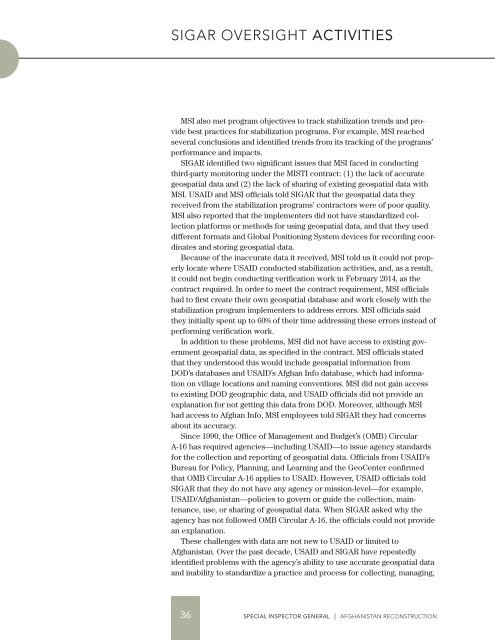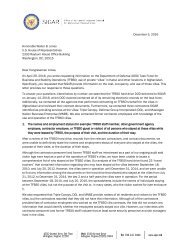SIGAR
2016-10-30qr
2016-10-30qr
You also want an ePaper? Increase the reach of your titles
YUMPU automatically turns print PDFs into web optimized ePapers that Google loves.
<strong>SIGAR</strong> OVERSIGHT ACTIVITIES<br />
MSI also met program objectives to track stabilization trends and provide<br />
best practices for stabilization programs. For example, MSI reached<br />
several conclusions and identified trends from its tracking of the programs’<br />
performance and impacts.<br />
<strong>SIGAR</strong> identified two significant issues that MSI faced in conducting<br />
third-party monitoring under the MISTI contract: (1) the lack of accurate<br />
geospatial data and (2) the lack of sharing of existing geospatial data with<br />
MSI. USAID and MSI officials told <strong>SIGAR</strong> that the geospatial data they<br />
received from the stabilization programs’ contractors were of poor quality.<br />
MSI also reported that the implementers did not have standardized collection<br />
platforms or methods for using geospatial data, and that they used<br />
different formats and Global Positioning System devices for recording coordinates<br />
and storing geospatial data.<br />
Because of the inaccurate data it received, MSI told us it could not properly<br />
locate where USAID conducted stabilization activities, and, as a result,<br />
it could not begin conducting verification work in February 2014, as the<br />
contract required. In order to meet the contract requirement, MSI officials<br />
had to first create their own geospatial database and work closely with the<br />
stabilization program implementers to address errors. MSI officials said<br />
they initially spent up to 60% of their time addressing these errors instead of<br />
performing verification work.<br />
In addition to these problems, MSI did not have access to existing government<br />
geospatial data, as specified in the contract. MSI officials stated<br />
that they understood this would include geospatial information from<br />
DOD’s databases and USAID’s Afghan Info database, which had information<br />
on village locations and naming conventions. MSI did not gain access<br />
to existing DOD geographic data, and USAID officials did not provide an<br />
explanation for not getting this data from DOD. Moreover, although MSI<br />
had access to Afghan Info, MSI employees told <strong>SIGAR</strong> they had concerns<br />
about its accuracy.<br />
Since 1990, the Office of Management and Budget’s (OMB) Circular<br />
A-16 has required agencies—including USAID—to issue agency standards<br />
for the collection and reporting of geospatial data. Officials from USAID’s<br />
Bureau for Policy, Planning, and Learning and the GeoCenter confirmed<br />
that OMB Circular A-16 applies to USAID. However, USAID officials told<br />
<strong>SIGAR</strong> that they do not have any agency or mission-level—for example,<br />
USAID/Afghanistan—policies to govern or guide the collection, maintenance,<br />
use, or sharing of geospatial data. When <strong>SIGAR</strong> asked why the<br />
agency has not followed OMB Circular A-16, the officials could not provide<br />
an explanation.<br />
These challenges with data are not new to USAID or limited to<br />
Afghanistan. Over the past decade, USAID and <strong>SIGAR</strong> have repeatedly<br />
identified problems with the agency’s ability to use accurate geospatial data<br />
and inability to standardize a practice and process for collecting, managing,<br />
36<br />
SPECIAL INSPECTOR GENERAL I AFGHANISTAN RECONSTRUCTION




